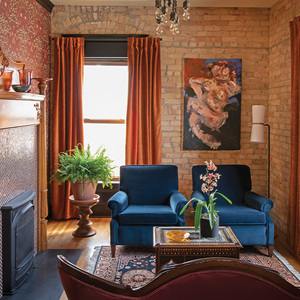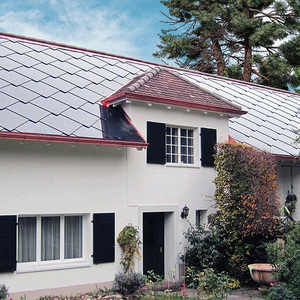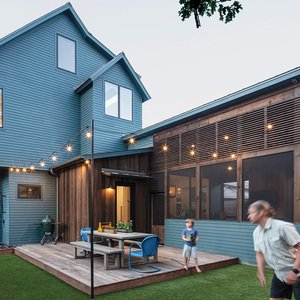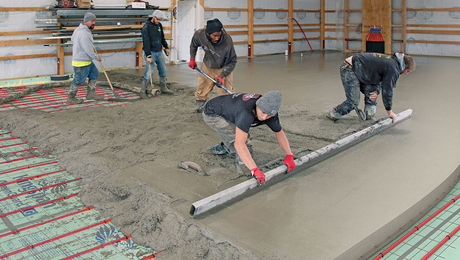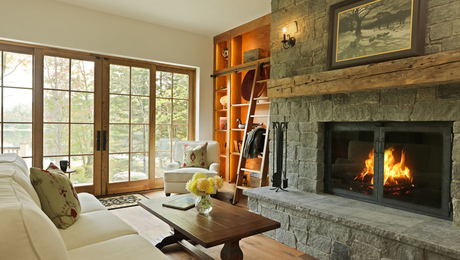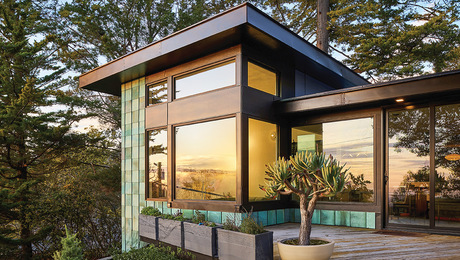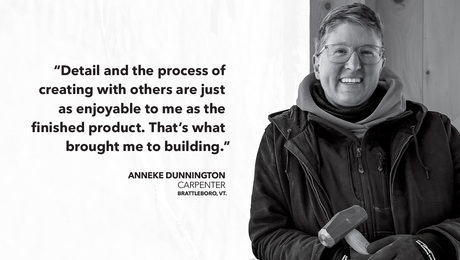Not Small, Just Right
Sarah Susanka talked us into considering larger homes for our Best Small Home award. Here’s why.
Many of us who work in the world of sustainable design and construction are quick to cast aspersions on any house that’s larger than we deem absolutely necessary. We know it’s possible to live in smaller spaces that adequately accommodate our needs, and we are eager to convert everyone else to our way of thinking. Our logic goes something like this: If we build less space and make that space super energy efficient, we can reduce our collective carbon footprint dramatically. So let’s get cracking! No more houses over (fill in the blank) square feet!
There’s a problem, however. The houses that we want everyone to adopt are excellent models of low-carbon-footprint living, but for most homeowners, a home of that size is an intriguing oddity, not an option they would ever consider. However charming the design, to most people, smaller isn’t better. It’s just less.
So if we keep dictating the amount of square footage to build and making people feel bad for building more than we consider reasonable, we’re inadvertently focusing on what has to be given up, and we’re turning people away from a set of ideas and technologies that could greatly enrich their lives if only they’d give them a try.
When Fine Homebuilding’s editor consulted with me about launching the best-small-home award, he was thinking that “small” should be defined as 1200 sq. ft. or less. I encouraged Brian to think about this category a little differently. Though the first two houses that won this award were under 1000 sq. ft., this year’s winner is 1600 sq. ft.
Good design for everyone
I’ve always believed that if you want to shift people’s opinions about something, you need to tell them what they’ll gain, not what they’ll lose. This is why throughout my architectural and writing careers, I’ve worked to articulate the benefits of “right-sizing” one’s home, rather than saying specifically what that right size should be.
My first article for Fine Homebuilding described a home that I’d designed for an elderly couple in Minnesota who had just lost their previous house to a fire. The focus of the article was the set of design principles I’d used to make their new house more engaging to live in. That set of concepts later became the heart of the series of home-design books I would eventually write.
Well before writing these books, though, I realized that it was not my job to judge my clients’ decisions about how much square footage to build. My job was simply to make the most of their budget by helping them to build the spaces they needed for their particular lifestyles, and to do so in such a way that the resulting house would fit them like a well-tailored suit. What I found was that this process usually required the elimination of underutilized spaces. No matter whom I was working for or how big their budget, the principle of less is more was always at play, but not because I was trying to talk my clients into building less just for the sake of building a smaller house. I found that if I could show them a way to build about a third less square footage than they thought they needed, they would have enough left in their budget to make the space truly beautiful and comfortable, as well as energy efficient. That’s what they really wanted. Rather than being a critic of their way of living, I became the hero that helped them realize their dreams.
A couple of years after I’d completed a second article, and after the editors had figured out that I loved writing about design, Taunton Press asked me if I would write a book called The Small House. I knew that wasn’t quite right. With that title, I’d only be preaching to the choir—a choir made up of that minority of people for whom a small house was already an acceptable solution to their housing needs.
I wanted to write a book that would appeal to anyone who was thinking about building a home, and I wanted to illustrate how one could make that home better rather than merely bigger. Having been shocked in the mid-1990s by all the humongous and often downright ugly houses springing up across vast stretches of recently developed farmland, I also wanted to write a book that would speak particularly to these buyers. But to inspire readers to take the ideas for right-sizing that I had to offer, I knew I would have to use a variety of home sizes to illustrate my point, not just ones that I considered right, which for me at the time would have been around 1500 sq. ft.
In the last paragraph of an early draft of the introduction to the book, I wrote, “This book shouldn’t be called The Small House, but The Not So Big House.” I knew immediately that was the title I’d been looking for—one that would appeal to people of all walks of life who were looking for a way to make their house better rather than bigger. It connoted smaller, but it wouldn’t automatically turn off someone looking at 3000 sq. ft. or more—the people who really needed what this book contained.
Size is not so significant
Paradoxically, Not So Big really has very little to do with size. The feeling of home is a quality, not a quantity, so Not So Big houses can come in many shapes and sizes. Not So Big is about building better rather than bigger, it’s about building sustainably, and it’s about building for the way we really live rather than for a bygone era when people lived much more formally than they do today. More than anything, it’s about making less do more, with the focus placed firmly on the “more” part of that equation, rather than the “less” part—more quality of life, more beauty, more inspiration for every day. It just so happens that less square footage gets built in the process.
I came upon this equation out of necessity. When I was being interviewed by prospective clients, they’d often tell me something like this: “We want 3000 sq. ft., we have a $350,000 budget, and we want our new house to look like these pictures.” I could tell instantly that if they wanted that many square feet, and they had only that amount to spend, there was absolutely no way to make the house come close to emulating the images they’d brought with them. Something had to give. Of course, it was not easy to be the messenger of this hard truth. I had to find a way of convincing them to do one of the following: lower their quality expectations, increase their budget, or reduce the amount of square footage they were planning to build.
I call this the “quality/quantity/cost triangle.” If you don’t allow one of these variables to go up or down as needed, you simply can’t build. What I discovered through years of working with clients to address this ever-present conundrum is that for most people, the variable that’s easiest to change is the quantity of space. This number has often been settled on somewhat arbitrarily, usually based on the square footages of friends’ houses, articles they’d read, or the sizes of homes they’d seen on the local Parade of Homes. I found that my clients were usually willing to build a bit smaller if I could make a convincing argument that the home they were about to build would actually feel more spacious than the house they were originally planning.
How does that work, you may ask. It’s certainly not about making smaller rooms. Instead, the trick lies in eliminating those rarely used spaces—the ones from our grandparents’ generation—so that what is built gets used every day. For most homeowners today, that means no more formal spaces, such as the formal living room, the dining room, and the two- or even three-story foyer. Those three rooms combined can constitute over a third of the space in some houses! If you need space for an occasional formal activity or an overnight guest stay, then you can make another space in the house do double duty. This strategy makes sense to most homeowners. But far fewer would be willing to build less square footage if they thought it meant living in cramped quarters. The amount of everyday space that a household needs varies tremendously. For some, 1200 sq. ft. is ample, while for others, 3000 sq. ft. feels too tight. For some, their house needs to accommodate just one or two residents who rarely entertain. For others, their home serves not only their own everyday needs, but also those of extended family or groups of visitors. I’ve had clients who’ve held weekly meetings for 50 or more in their home, and I’ve designed houses for extended families of as many as 24, who gather for a month or two each summer.
It’s about quality of life
Since its inception, Fine Homebuilding has had incredible reach and influence, playing a parallel role to that of my books in swaying the opinions of its readers about what to build. In addition to being my own favorite source of inspiration, the Houses issue is looked forward to and treasured each year by thousands of architects, builders, craftspeople, and homeowners across the country. I have a special shelf just for these cherished issues. Their pages illustrate the very best of what the architects, designers, builders, and artisans of this country can produce. Just as the choice to use a less limiting title for my book meant I would reach many more people with its message, Fine Homebuilding’s choice to show houses of many sizes within these pages means a much larger number of people can envision a better and more sustainable dwelling place for themselves. That promotes a far greater reduction in both square footage and carbon emissions overall than if the stories herein were targeted only at the few who are ready and willing to build small.
I believe it’s time for us to take our eyes off specific square-footage goals and to start promoting what really makes a difference in quality of life. In the process, houses will get smaller, but no one will object, or perhaps even notice, because those houses will be so much better and so much more livable—the direct result of better design and better tailoring to the way we actually live.
What does small mean to you?
Different lifestyles require different types and amounts of space.
—Mike Pudelwitts
“Right size” flows, invigorates…brings people together.
—Jason Jones
1200 to 1500 sq. ft. is a good size for a small house with a comfortable living space.
— Lawrence Valenza
For how many people? That is the question.
—Matthew Amann



